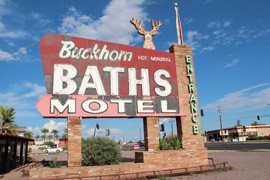Cronkite News has moved to a new home at cronkitenews.azpbs.org. Use this site to search archives from 2011 to May 2015. You can search the new site for current stories.
Mesa group works to preserve neon history along Main Street
MESA – Before interstate freeways and TripAdvisor.com, this city’s Main Street glistened with neon to lure weary travelers to motels.
“From quite a distance, you’re traveling in your car, you’re tired, you want to stop for the night or get something to eat,” said Victor Linoff, president of the Mesa Preservation Foundation. “These signs pulled you in. They were like beacons in the night.”
Today, neon signs still stand on this stretch of Main Street, including in front of Buckhorn Baths and Kiva Lodge Motel. But others have gone away, victims of business closures and the elements.
Hoping to save what’s left of a bygone era and enhance the area, Linoff’s group is taking steps to keep the remaining neon signs aglow. Its first goal is raising $65,000 to repair the Starlite Motel’s animated, 78-foot diving lady sign, a Main Street icon damaged in a 2010 hailstorm.
“It is the last example of animated neon,” Linoff said. “It represents a different era, and people don’t generally think of signs as historic.”
The foundation has yet to reach its fundraising goal and reanimate the diving lady, but when that happens it plans to move on to other signs and also reopen the historic Buckhorn Baths, a motel and mineral springs popular with baseball players in the 1940s.
“We would like to leave something of a legacy to show another generation what came before,” Linoff said.
Tucson also has seen an effort to restore neon signs at motels along Miracle Mile, Oracle Road and Drachman Street, known as Miracle Mile Strip. The area developed a reputation for drugs and prostitution, and the Tucson Historic Preservation Foundation saw neon as a way to revitalize the area.
“They are emblematic of the classic automobile age in America,” said Demion Clinco, president of the Tucson Historic Preservation Foundation. “That mid-century modern highway culture that just doesn’t exist anymore.”
Helped by an amendment to the city’s sign code in 2011, Clinco’s group, partnering with Pima Community College, restored and reinstalled four iconic neon signs.
“There’s tremendous economic development potential because of them,” Clinco said.
Thomas Combrink, research specialist at Northern Arizona University’s W.A. Franke College of Business, said neon is largely associated with the heyday of Route 66. While communities along Route 66 in Northern Arizona withered after Interstate 40 came along, neon signs remain a draw.
“It’s one more thing that’s different,” Combrink said. “It’s something that speaks to a bygone era.”
Michelle Streeter, director of public relations for the Mesa Convention and Visitors Bureau, said because of neon’s historical impact restoring signs like the diving lady could make Main Street more of a draw.
“When it’s erected, I think people are going to find their way back to Main Street to take a look at that sign because that has always been a treasured icon for Mesa,” she said.








